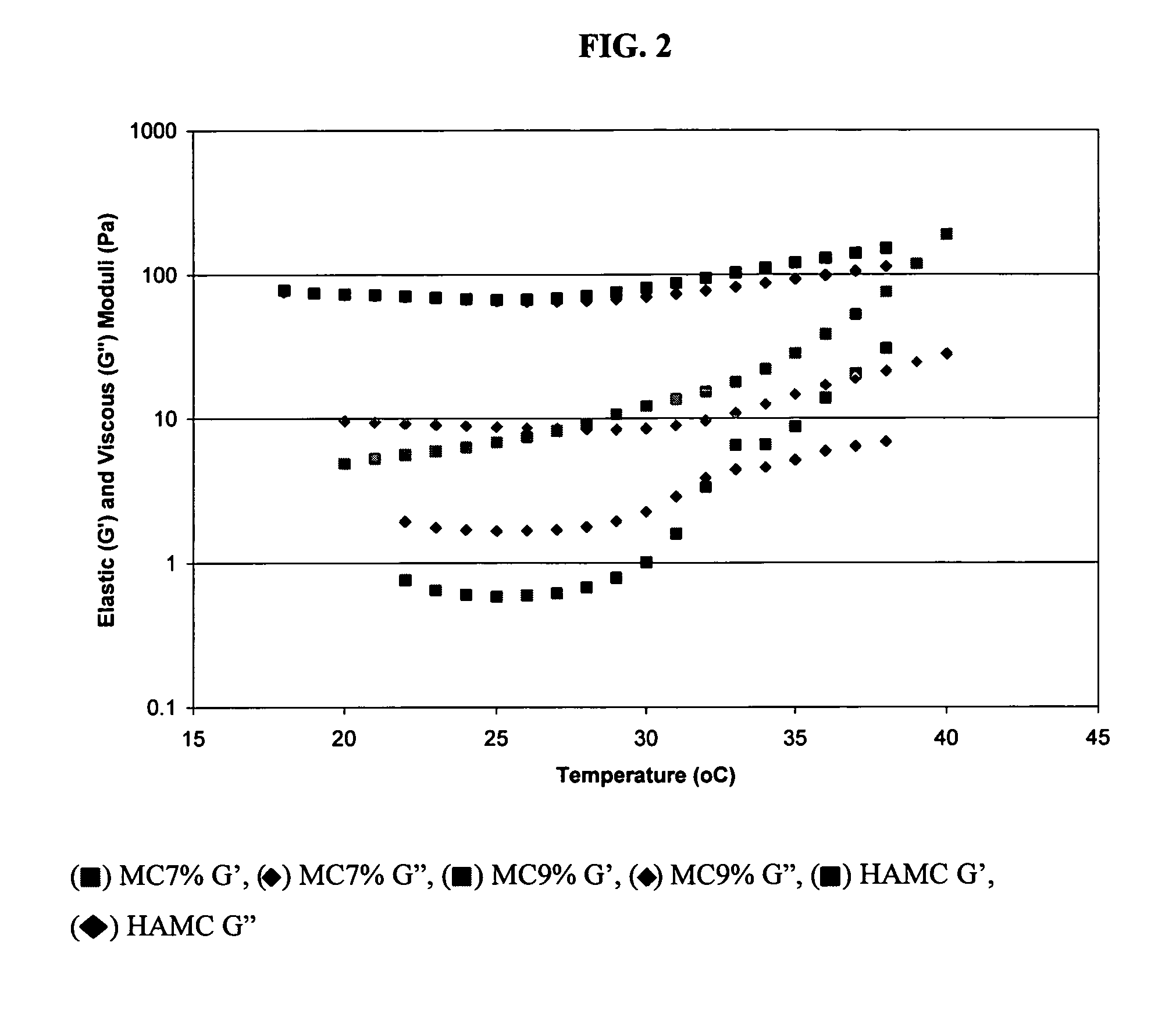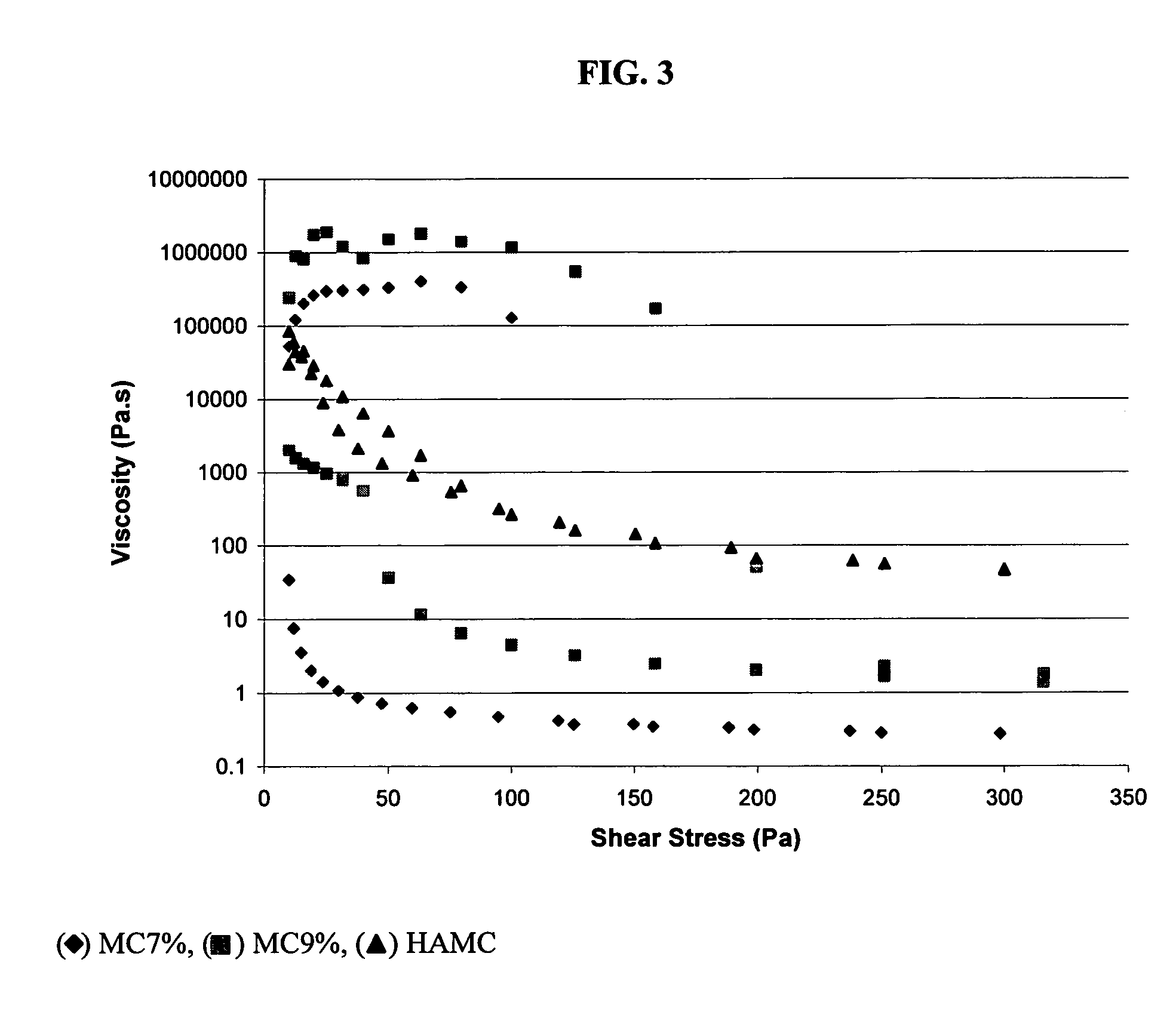Blends of temperature sensitive and anionic polymers for drug delivery
a technology of anionic polymers and dyes, applied in the field of polymer matrix, can solve the problems of not describing or suggesting the use of nonionic polymers, and achieve the effect of promoting interactions
- Summary
- Abstract
- Description
- Claims
- Application Information
AI Technical Summary
Benefits of technology
Problems solved by technology
Method used
Image
Examples
example 1
I. Blend of 2% Hyaluronic Acid and 7% Methylcellulose
[0056]The polymer matrix components were sterilized as indicated and produced under sterile conditions. Methylcellulose (MC) A15 PREM LV (Dow Chemical) was autoclaved for 20 minutes at 120° C. To produce 10 ml of a 7% methylcellulose solution, 4 ml of sterile-filtered artificial cerebrospinal fluid (aCSF)(148 mM NaCl, 3 mM KCl, 0.8 mM MgCl2, 1.4 mM CaCl2, 1.5 mM Na2HPO4, 0.2 mM NaH2PO4, 0.1 mg / ml bovine serum albumin) was heated to 90° C. and mixed with 0.7 g MC powder until all polymer particles were wetted. The remaining 5.3 ml aCSF was added cold and the mixture shaken in an ice bath for at least 30 minutes.
[0057]Hyaluronic acid (HA) (MW 1500000, Novamatrix) was sterilized by filtering a 0.1% HA solution in Millipore distilled water (ddH2O) through a 0.22 μm PES filter (Nalgene). The solution was then lyophilized under sterile conditions by covering falcon tubes with nylon 0.2 μm filters (Millipore).
[0058]HAMC is a physical ble...
example 2
I. Application of HAMC for Intrathecal Injection
[0071]The drug delivery synergistic polymer matrix in Example 1 has been used for injection into the intrathecal space using a 30 G needle in Sprague-Dawley rats. A laminectomy was performed at the T2-T3 spinal level and 10 μl of sterile HAMC injected into the SAS using an anterior chamber cannula (BD Visitec). The needle is a 30 G needle, 22 mm long with a 45° angle blunt tip 4 mm from the end. The dura matter overlying the left dorsal rootlets was lifted with forceps (Dumont biologic tip, #5, FST) and punctured with a sharp 30 G needle at T3. The cannula was inserted through the dural opening and 10 μl of HAMC was injected rostrally using a 1 ml Luer-loc syringe (BD Biosciences). The cannula was maintained intrathecally for an additional minute to prevent backflow. After injection, the animals were sutured.
[0072]Twenty eight female Sprague Dawley rats were used to assess the effects of HAMC on behavior, histology and immunohistochemi...
example 3
Blend of 2% Hyaluronic Acid and 2% Chitosan / β-Glycerophospate Solution
[0078]Thermal gelling chitosan was produced as described by Chenite et al. Chitosan (Novamatrix, Norway) was autoclaved at 120° C. for 20 minutes. Under sterile conditions, 200 mg of chitosan was dissolved in 9 ml of 0.1 M HCl solution. 560 mg of glycerophosphate disodium salt (Sigma) was dissolved in 1 ml of dd H2O, and this solution was added drop by drop into the cold chitosan solution, resulting in a 2 w / v % thermal gelling chitosan solution. Blends of CH with HA were made similarly to the blends of MC with HA as described in Example 1. HACH is a physical blend of 2% HA dissolved in a 2 wt % CH solution.
[0079]Unlike methylcellulose, chitosan is enzymatically degradable, potentially providing further control over degradation rates and greater ranges of molecular weights that can be used. The 2% CH solution required 20 minutes of incubation at 37° C. for the gel to not flow by the inverted tube test. By blending...
PUM
| Property | Measurement | Unit |
|---|---|---|
| molecular weight | aaaaa | aaaaa |
| molecular weight | aaaaa | aaaaa |
| gelling temperature | aaaaa | aaaaa |
Abstract
Description
Claims
Application Information
 Login to View More
Login to View More - R&D
- Intellectual Property
- Life Sciences
- Materials
- Tech Scout
- Unparalleled Data Quality
- Higher Quality Content
- 60% Fewer Hallucinations
Browse by: Latest US Patents, China's latest patents, Technical Efficacy Thesaurus, Application Domain, Technology Topic, Popular Technical Reports.
© 2025 PatSnap. All rights reserved.Legal|Privacy policy|Modern Slavery Act Transparency Statement|Sitemap|About US| Contact US: help@patsnap.com



